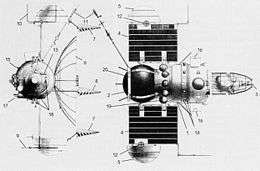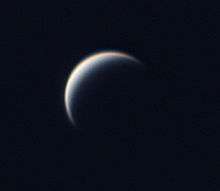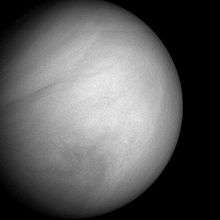Venera 7
 Venera diagram | |
| Mission type | Venus lander |
|---|---|
| Operator | Lavochkin |
| COSPAR ID | 1970-060A |
| SATCAT № | 4489 |
| Mission duration | 120 days |
| Spacecraft properties | |
| Spacecraft | 4V-1 No.630 |
| Manufacturer | Lavochkin |
| Launch mass | 1,180 kilograms (2,600 lb) |
| Landing mass | 500 kilograms (1,100 lb) |
| Start of mission | |
| Launch date | 17 August 1970, 05:38:22 UTC |
| Rocket | Molniya-M |
| Launch site | Baikonur 31/6 |
| End of mission | |
| Last contact | 15 December 1970, 06:00 UTC |
| Orbital parameters | |
| Reference system | Heliocentric |
| Venus lander | |
| Landing date | 15 December 1970, 05:37:10 UTC |
| Landing site | 5°S 351°E / 5°S 351°E |
The Venera 7 (Russian: Венера-7 meaning Venus 7) (manufacturer's designation: 3V (V-70)) was a Soviet spacecraft, part of the Venera series of probes to Venus. When it landed on the Venusian surface, it became the first spacecraft to land on another planet and first to transmit data from there back to Earth.[1]
Launch
The probe was launched from Earth on August 17, 1970, at 05:38 UTC. It consisted of an interplanetary bus based on the 3MV system and a lander.[2] During the flight to Venus two in-course corrections were made using the bus's on-board KDU-414 engine.[2]
Landing
It entered the atmosphere of Venus on December 15, 1970.[2] The lander remained attached to the interplanetary bus during the initial stages of atmospheric entry[2] to allow the bus to cool the lander to −8 °C for as long as possible.[2] The lander was ejected once atmospheric buffeting broke the interplanetary bus's lock-on with Earth.[2] The parachute opened at a height of 60 km and atmospheric testing began with results showing the atmosphere to be 97% carbon dioxide.[2] The parachute appeared to fail during the descent, resulting in a descent more rapid than planned.[2] As a result the lander struck the surface of Venus at about 16.5 metres per second (54 ft/s) at 05:37:10 UTC.[2] Landing coordinates are 5°S 351°E / 5°S 351°E.[3]
The probe appeared to go silent on impact[2] but recording tapes kept rolling.[4] A few weeks later, upon a review of the tapes, another 23 minutes of very weak signals were found on them.[4] The spacecraft had landed on Venus and probably bounced onto its side, leaving the medium gain antenna not aimed correctly for strong signal transmission to Earth.[4]
The probe transmitted information to Earth for 53 minutes, which included 20 minutes from the surface. It was found that the temperature at the surface of Venus was 475 °C (887 °F) ° ± 20 ° C and the pressure was 90 ± 15 atmospheres.[2][5] The pressure corresponded to approximately 900 m below sea level. The probe provided information about the surface of Venus, which could not be seen through a thick veil of atmosphere. The spacecraft definitively confirmed that humans cannot survive on the surface of Venus, and excluded the possibility that there is any liquid water on Venus.
See also
References
- ↑ "Science: Onward from Venus". TIME. 8 February 1971. Retrieved 2 January 2013.
- 1 2 3 4 5 6 7 8 9 10 11 Reeves, Robert (1994). The Superpower Space Race: An Explosive Rivalry through the Solar System. Plenum Press. pp. 211–215. ISBN 0-306-44768-1.
- ↑ Patrick Moore, The data book of astronomy. CRC Press, 2000, p. 92.
See Table 5-5, Missions to Venus, 1961-2000. Landing near Navka Planitia - 1 2 3 Larry Klaes, THE SOVIETS AND VENUS, PART 1, 1993.
- ↑ Итоги работы станции "Венера-7"
External links
- Venera 7 NASA NSSDC Master Catalog Data
- Plumbing the Atmosphere of Venus


